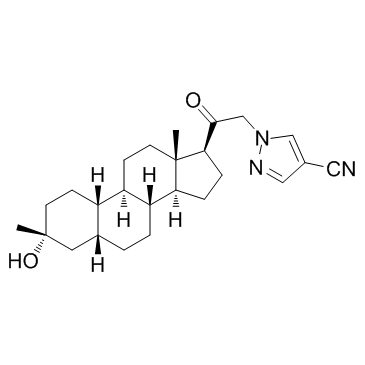| Description |
SAGE-217 is a potent GABAA receptor agonist with EC50s of 296 and 163 nM for α1β2γ2 and α4β3δ GABAA receptors, respectively.
|
| Related Catalog |
|
| Target |
EC50: 296 nM (α1β2γ2 GABAA receptor), 163 nM (α4β3δ GABAA receptor)[1]
|
| In Vitro |
Kinase assay demonstrates that SAGE-217 is a potent GABAA receptor agonist with EC50s of 296 and 163 nM for α1β2γ2 and α4β3δ GABAA receptors, respectively. SAGE-217 is currently being studied in parallel phase 2 clinical trials for the treatment of postpartum depression (PPD) and major depressive disorder (MDD). SAGE-217 shows >30 μM inhibition in a cardiac panel of eight relevant cardiac ion channels. At 10 μM concentration of SAGE-217, only binding at the glycine (57%), sigma receptors (88%), and inhibition of the transient receptor potential vanilloid 1 (TRPV1, 95%) is noted[1].
|
| In Vivo |
Acute administration of SAGE-217 (0.3 to 10 mg/kg, ip) effectively reduces pentylenetretazol (PTZ)-induced seizures in mice (MECplasma=85 nM) as well as produces a dose-dependent anticonvulsant effect in the mouse 6 Hz electrical stimulation model. In the rat lithium-pilocarpine model of status epilepticus (SE), SAGE-217 (0.3 to 5 mg, iv) abolishes both behavioral and electrographic seizure activity, even when administered 60 min after induction of SE. Additional PK studies of SAGE-217 in dog show low clearance (<10% of hepatic blood flow), resulting in excellent oral bioavailability (F=68%)[1].
|
| Kinase Assay |
Cortices are rapidly removed following decapitation of euthanization by carbon dioxideasphyxiation Sprague-Dawley rats (200 to 250 g). The cortices are homogenized in 10 volumes of ice-cold 0.32 M sucrose using a glass/teflon homogenizer and centrifuged at 1500× g for 10 min at 4°C. Aliquots (100 μL) of the membrane suspensions are incubated with 3 nM [35S]-TBPS and 5 μL aliquots of SAGE-217 dissolved in DMSO (final 0.5%) in the presence of 5 μM GABA. The incubation is brought to a final volume of 1.0 mL with buffer. Following a 90 min incubation at room temp, the assays are terminated by filtration through glass fiber filters using a cell harvester and rinsed three times with ice-cold buffer. Filter bound radioactivity is measured by liquid scintillation spectrometry[1].
|
| Animal Admin |
In vivo pharmacokinetic parameters are determined in male Sprague Dawley rats (of 200 to 300 g in weight), male CD-1 mice (15 to 25 g in weight), and male beagle dogs (8 to 12 kg in weight). Doses of SAGE-217 for intravenous (IV) and oral administration (PO) are formulated as solutions in SBECD. SAGE-217 is dosed IV (5 mg/kg, 2.5 mL/kg) or by oral gavage (20 mg/kg, 10 mL/kg). Animals in the IV group are sampled at 0.083, 0.25, 1, 2, 4, and 8 hours post-dose and PO animals are sampled at 0.5, 1, 2, 4, and 8 hours post dose. Brain samples from the IV group are also collected at 1 hour post-dose. Blood samples are collected into tubes treated with K2-EDTA, then centrifuged at 2000 g at 4°C for 15 min. Plasma is isolated and frozen at -70°C until extraction[1].
|
| References |
[1]. Martinez Botella G, et al. Neuroactive Steroids. 2. 3α-Hydroxy-3β-methyl-21-(4-cyano-1H-pyrazol-1'-yl)-19-nor-5β-pregnan-20-one (SAGE-217): A Clinical Next Generation Neuroactive Steroid Positive Allosteric Modulator of the (γ-Aminobutyric Acid)A Receptor. J Med Chem. 2017 Sep 28;60(18):7810-7819.
|
